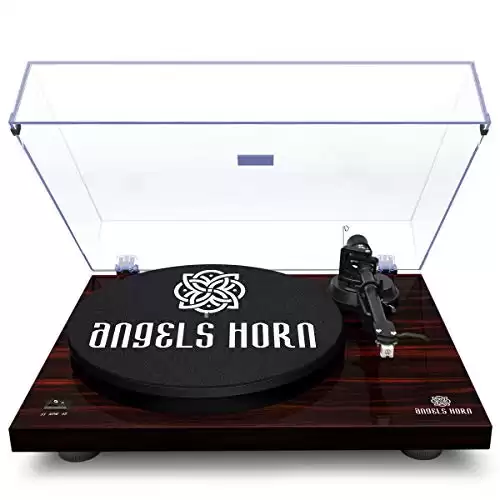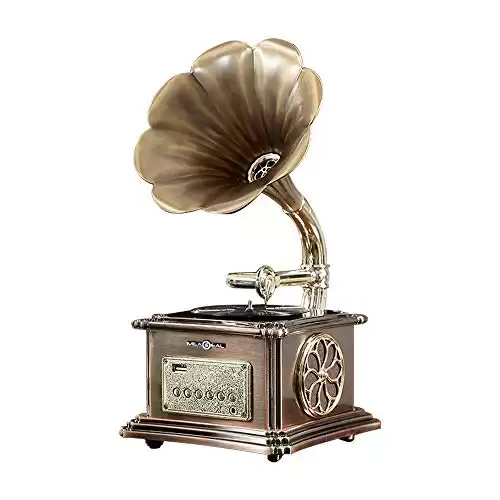If you look at most vinyl records from the 1950s and 1960s, you’ll see that almost all of them are colored black.
Although the technology was available to create colored vinyl, the products typically offered more hissing and background noise than the traditional black records.
Record companies stayed as far away as possible from colored vinyl records to ensure each artist could maximize their sales.
Technology developments over the past sixty years have changed the records industry. As our culture embraces the idea of vinyl once again, the preferences for colored products keeps growing each year.
Colored Vinyl vs. Black Sound Quality
Although it takes more work for colored vinyl to have the same sound quality as black, the pressings are about equal today. There are always exceptions, especially with picture discs, but these issues should stop anyone from buying records.
The record production process has a more significant influence on a vinyl record’s quality, whether it is colored or black.
If an album is consistently poor, the issues involve the mastering and pressing processes or the production plant’s quality assurance standards.
If you’re ever in doubt about what option to purchase for a specific pressing, try reading the product’s online reviews to see how others feel about it.
In most circumstances, other collectors and audiophiles have heard the playback and can let you know what to expect when you play it.
■ How Are Colored Vinyl Records Created?
Every vinyl record, no matter what its color, is made from PVC. That means it starts with a naturally colorless material.
Manufacturers mix additives into the PVC to have it achieve the desired color.
Black records were always considered better in the past due to the dark carbon that got added to the base material.
The carbon strengthens the PVC mix, creating a more tangible recording medium for each pressing.
When you create a colored vinyl record, the manufacturing process uses dyes to make the color.
Although this product doesn’t strengthen the vinyl, today’s sound qualities offer a minimal difference in audio quality.
It wasn’t that way in the past.
Mistakes are easier to make when you’ve got colored vinyl records, which increases the risk of having poor audio quality pressed into the material.
The issues get even worse when using a glow-in-the-dark or clear pressing to achieve results.
When there aren’t any additives mixed into the clear PVC, a worse sound almost always develops.
Although it’s difficult to detect this outcome from a standard turntable, you can hear it when listening to high-quality headphones, IEMs, or earbuds.
Why Are Picture Discs Problematic for Vinyl?
Picture discs are about the worst style of vinyl record you can purchase. Instead of using two layers to create the album, manufacturers must use a third to create the desired image.
The first layer becomes the clear record that contains no music. The second layer includes the picture, while the third one is the transparent sheet containing the grooves that transmit sound.
The final layer is a thin plastic that isn’t as durable because of its malleability.
That means your playback options and long-term use are called into question.
When glow-in-the-dark pigments get added to the image layer, the ink deteriorates the acoustic properties found in that thin plastic.
This issue almost always results in higher levels of surface noise.
Why Are Picture Discs More Expensive?
If colored vinyl produces an inferior result, why are the records more expensive than they are with black albums?
From a materials-based perspective, it costs more to produce colored vinyl.
Even with the industry innovating new production practices, the overhead is about $1 more than it is for black vinyl.
This issue is due to the cost of pigments and dyes vs. the expense of dark carbon.
Most producers created limited color vinyl batches, which also gives this product extra scarcity.
When it is harder to obtain specific items from a store, the cost goes up.
Since many of these items have an aesthetic appeal, people buy them for their visual aesthetics more than the sound quality.
Imagine having the original Ghostbusters album colored neon green with an image of Slimer on it. Instead of playing it on your turntable, you’d probably keep it in a collector’s album.
The opposite effect also happens. If there are fewer black vinyl records available in the market compared to the colored ones, you’ll see a lower price on the dyed product.
Most collectors prefer colored wax because of its perceived value. It is a unique product that creates the equivalent of a comic book with variant art.
The material you receive might be the same, but it is the looks that set apart one issue from another.
Best Examples of Colored Vinyl Collectability
Although you won’t find many colored vinyl examples from the Golden Era of music, the desirability and price of some famous records are directly reflected with these unique pressings.
Here are some of the best examples of how colored vinyl enhances the collector’s experience to make a specific item more favorable (and more expensive) to purchase.
■ Nevermind: Nirvana
This album has more than 140 pressings since its release. Several different colors, skin-folds, and other changes have been included during those releases to enhance each one’s collectability.
When the 2009 re-release on black vinyl hit the market, the record price was about $55.
If you tried to purchase the same album printed with a blue translucent finish, you’d pay three times that figure at the retail level.
■ 2001: A Space Odyssey Soundtrack
The black vinyl media price for this record was set at $20. Although that’s a little high compared to a digital download or CD, it’s still a reasonable cost.
If you received one of the randomly inserted colored vinyl versions of this record, the price suddenly skyrockets to $90 or more.
Although the sound quality is essentially the same, the scarcity of the colored wax is what drives up the cost.
■ Madonna: like a Virgin
One of the most notable colored vinyl releases in recent years was the white hues on this record. It was a promotional gimmick that spoke of the “innocence” of the song.
If you were to purchase the regular LP, the cost would be about $15. You can still find some sealed versions online that retail for about $25.
The white LP currently sells in a used condition for $50. If you want it sealed, that cost could rise to $75 or more.
This list of colored vinyl records keeps an account of the major releases that have used this medium since 1908.
Best Record Players for Playing Colored Vinyl
If you want to play your colored vinyl records instead of keeping them as a collector’s item, you’ll need a high-quality turntable to get the results you desire.
These products are proven winners when you need a new record player for at home.
1. Angels Horn Vinyl Turntable
This turntable offers excellent balance and stability so that you get the sound quality you deserve.
It provides two speeds: 45 and 33 1/3. You receive a nice spin with its DC servo motor and a belt-drive system that perfectly interprets the sound grooves in your favorite records.
A preamp and line output come included with the design to offer authentic sounds, while the anti-skating weight gives you a true roll without pressing into the disc with too much weight.
2. Retro Vintage Gramophone Turntable
With this unique turntable, you’ll get to enjoy the vibes of yesteryear while benefiting from modern technology.
It uses a Bluetooth speaker to create beautiful sounds from your favorite playlists or plays your colored vinyl records with two built-in 15W options.
The design will become the centerpiece of your home with the copper horn, aluminum base, and antioxidation plating.
Whether you need to give someone a gift or you’re shopping for yourself, the traditional phonograph style comes alive with this product.
3. 1byone Wireless Turntable
If you want one of the best vinyl record turntables available today, you’ll want to take a closer look at this product.
It features a solid iron platter developed through precision manufacturing to create outstanding stability and rotation.
Although it can be a little challenging to install to get the best sound, you can take advantage of the adjustable counterweight force to enjoy your colored LPs with ease.
You can switch between a preamp or a phono line, connected to the bookshelf speakers, or record music to your PC.
Colored Vinyl vs. Black: Which Is Better
If you love listening to vinyl records, it doesn’t matter what color the disc is when you play it today.
Although some picture-based designs have an inferior quality after hundreds of uses, the average person won’t need that much durability.
The best vinyl turntables deliver a stable performance with anti-skipping technology to play any discs smoothly.
You won’t see the needle bouncing or the speeds inconsistent, which means you can hear the composition or audio as it was intended.
If you love listening to music, you’ll adore what the best turntables offer.
When you pair that up with your colored or black records, the experience is incredible!
You just might want to be careful playing those colored vinyl discs too often.
If you have a limited edition product, an unplayed product could become quite valuable!




